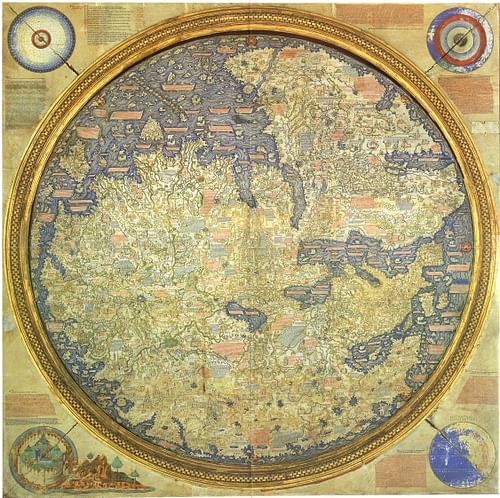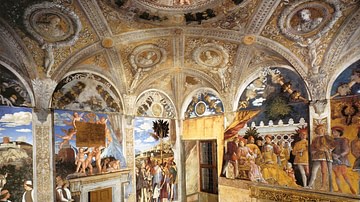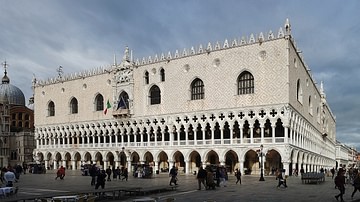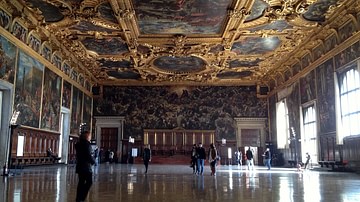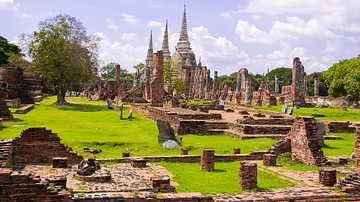The Doge's Palace, or Palazzo Ducale, in Venice, Italy, was the seat of power of one of the world's most powerful city-states, as the Venetian Republic dominated the Mediterranean for centuries. The bright façade of the palace marks the very heart of Venice on the shore of the Venetian lagoon.
Its gothic style was described by John Ruskin as "the great work of Venice," the construction of which employed Venice's "best architects in its masonry, and the "best painters in its decoration…" (Ruskin, 193). Historian Luigi Serra defined the Doge's Palace as "the most gorgeous residence of a ruler ever planned by the human mind" (Serra, 3). The palace was the command center of the republic until it was conquered by Napoleon Bonaparte in 1797.
The doge ruled two empires: one on terra firma, the lands of the northeastern Italian peninsula which literally fed the city of Venice and provided shipbuilding timber and materials. The second empire was at sea, as the Venetian Republic controlled ports along the Adriatic, across the Mediterranean, and into the Black Sea. This power was administered from the Doge's Palace, and a short walk down the shoreline led to the shipyards of the Arsenale (arsenal), where ships were constructed for commerce and for the Venetian navy. Men and women worked there, in a variety of trades including carpentry, ropemaking, ironworking, and sailmaking.
History of the Doge's Palace
The origins of the structure were in the 900s, and the name of its original architect was lost to time. By 1341, the façade of the building was set. Major changes in the structure were made after a series of devastating fires, in 1458 and twice in the 1570s. Each time the building was rebuilt and enlarged, and lost artwork was replaced. The expansion of government councils led to additional reconstruction of the meeting halls.
From the 1200s to the 1600s Venice dominated trade across the Mediterranean basin. From the Palace, the doge commanded the Venetian Republic's military, including a naval fleet that held control over ports and protected their trade routes. The Venetian state had a diplomatic service to manage relations with foreign states and cartographers to develop maps for navigation. The palace was protected by security and intelligence-gathering groups, including the Lords of the Night (Signori di Notte), who pursued suspected enemies of the state.
Role of the Doge
The first doge began his rule in 697, and by the 12th century, the traditions of nominating and electing a doge through a convoluted series of secret ballots using urns and balls was established. A single individual was chosen to rule until he died. Unlike monarchs, the position of the doge was for life but was not hereditary. At the end of the long process of electing a doge, the new leader took an oath at the Basilica San Marco and was presented to the Venetians. His legitimacy did not derive from higher authority, but rather his election "expressed the will of the Venetians," and the doge's independence was limited by them (Lane 87). After 1486, the doge was required to live within the palace and essentially became a captive of the councils who monitored his communications and forbade him to leave the city without their permission.
Candidates for doge were selected from a well-defined nobility codified in Venice's Golden Book (Libro d'Oro) and the lesser nobility in the Silver Book (Libro d'Argento). Most were above the age of 70 when elected, which might mean a short reign. Upon his death, the complex process began anew. Electors favored military veterans and those who had served as procurators, entrusted with judicial power, a post regarded as "the ladder to the dogeship" (Sanudo, 51).
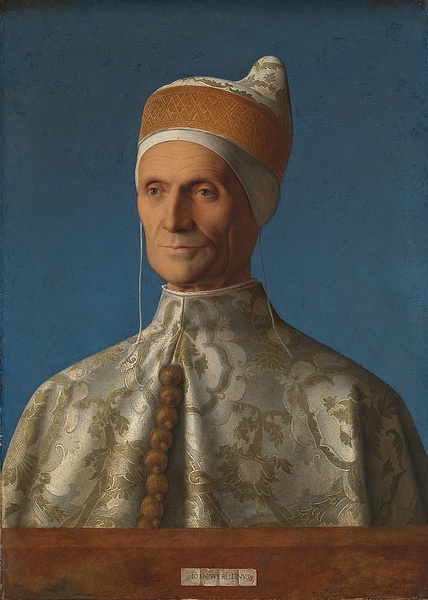
The doge wore a uniform marked by a peaked hat and ermine robes as symbols of his power. The doge also performed state ceremonies, including riding out in his gilded ceremonial barge, the Bucintoro, to the Marriage to the Sea (Festa della Sensa) ceremony where he made a vow and threw a golden ring into the lagoon. This signified the Venetian respect for the sea as a source of their prosperity. Although he ruled with six advisers, one from each section (sestiere) of the city, the pyramid of political power included the Council of Ten, the Forty and the Senate, and the Great Council composed of the nobility.
The doge worked in public rooms filled with maps and globes where he could gather intelligence and plan strategy. The palace held an armory of weapons of war, armor, torture devices, and even small cannons. Captured war trophies were displayed to celebrate the Republic's military victories. In 1609, Doge Leonardo Donato and his ministers hosted scientist Galileo Galilei, who arrived to exhibit his telescope. Galileo showed the doge that the telescope made it possible to identify ships "…two hours before they became visible to the naked eye" (Westfall, 16). This was an enormous advantage for the Venetians, and the doge used the power of patronage to reward Galileo with money and a position at the University of Padua.
Venice's republic rarely faced political threats, but in 1310, Bajamonte Tiepolo attempted a coup and was banished for life. After another plot, Doge Marian Falier was sentenced to death for treason in 1355. In the hall of doges' portraits, a black shroud was painted over Falier's face after his execution.
Architecture
Beyond the graceful lines of the structure, the palace symbolized the wealth and power of the Venetian Republic. The palace is a three-sided complex built next to the Basilica San Marco: at the ground level is an arched white stone colonnade, above it a loggia spanning the west and south sides which is crowned with gothic tracery quatrefoil openings called oculi in white Istrian stone, and the upper levels are clad in a pattern of pink and white stone set in an oblique pattern.
All the buildings in Venice rest upon a forest of timber hammered into the lagoon, then topped with stone foundations as a base for each structure. The ground-level colonnade, which rises from the piazzetta (public square) to the upper floors, appears significantly shorter today, since repeated floods led to raising the stone pavement to mitigate damage.
Visitors to the palace would climb the Golden Staircase (Scala d'Oro) to reach the upper floors. This passage was designed to awe both Venetians and foreign visitors. As they ascended to the upper floors, where the doge and the Councils met, they passed through an elaborately decorated staircase lined with paintings and clad from floor to ceiling in gold.

The palace artworks illustrate the history of the Venetian Republic by artists such as Jacopo Tintoretto, Paolo Veronese, Gian Domenico Tiepolo, and Giovanni Bellini. The largest painting covers an entire wall in the Great Council chamber, which is 53 meters (173 ft) long and 25 meters (82 ft) wide and can seat 2,000 people. On the back wall is one of the largest oil paintings on canvas in the world: The Glory of Paradise (La Gloria del Paradiso) by Jacopo Tintoretto, created to replace a painting destroyed by the fire of 1577. The massive work spans 22 meters by 8 meters (75 ft by 23 ft). Jacopo Tintoretto began work on it, and then his son Domenico took over its completion (Della Rovere, 27). The ceilings are inset with more paintings, ringed from floor to ceiling in gold.
From the east wall, the Bridge of Sighs (Ponte dei Sospiri) spans the canal as a direct link from the palace to the prison. Criminals could be tried in the palace and then marched over the bridge into the prison. Serious crimes might lead to execution on the piazzetta in front of the palace.
The center of the complex is an open-air courtyard. Covered walkways or loggia surround both the interior and exterior of the building so that Venetians could walk protected from sun and rain. The courtyard is crowned by the Giants' Staircase, from which the doge made ceremonial appearances. Flanking the top of the staircase are two larger-than-life statues of the gods Mars and Neptune. In 1404, a balcony was added on the west side, so that the doge could address crowds on important occasions.
On the west side is the Paper Gate (Porta della Carta) designed by Giovanni and Bartolomeo Bon in the late 15th century, which served as a ceremonial entry and a site for posting legal notices. Above the gate is a sculpture of Doge Francesco Foscari kneeling before the Venetian lion, which portrayed the doge as the servant of the state and subject to its will.
Further to the west of the palace was the state mint where Venice produced its currency, gold ducats called zecchini. This coin was backed with an image of the city's symbol, a winged lion holding a sword. Venetian merchants used these coins for domestic use and trade, along with Murano glass beads, which were made on an island north of the city.
Functions of the Palace
The palace connected on its north side to the Basilica San Marco. The palace included an apartment for the doge with a private chapel, as well as a corridor for the Doge to enter the basilica directly from his rooms. The palace held all government chambers, including the Senate and the Councils. Politicians met in a series of connected rooms and could consult the doge and other officials within the building. The expansion of Venetian power brought in additional groups who operated from within the palace. There were offices for magistrates, advocates, spies, and security officials who operated inside the building and the prison. Over time the palace expanded to accommodate these functions.
To protect commercial and political relations across the Mediterranean, the doge received reports from Venetian diplomats abroad. Venice's most lucrative trade was with Egypt, the source of valuable products like pepper, spices, and cotton. The palace housed cartographic experts who gathered and produced navigational maps for the Venetian navy and traders. When Marco Polo and his family returned from their voyages to the Black Sea and China, they provided valuable details on trade routes. These cartographers included Fra Mauro, who created a map of the world (mappa mundi) for the palace in 1450 CE to summarize all known geographical information.
The Doge's Palace was also the seat of justice, as well as a center for information on its commercial rivals and political enemies. A city-state of such wealth needed protection. The Lords of the Night were responsible for security within the palace and in the city. They met daily in the palace and went out on nightly patrols throughout Venice. They also kept gamblers and criminals from the areas surrounding the palace and basilica.
The Lords of the Night gathered anonymous tips which had been deposited in letter boxes known as Bocche di Leone (Lion's Mouths) inside the palace. These accusations were investigated by the Lords who rounded up suspects for questioning. In the beginning, there was a single investigator, then the Lords expanded to one in each section of the city then into a force of more than a hundred patrollers with the power to arrest and even torture suspects. Their powers included control of the prison beside the palace and the power to convict as well as pardon the accused. These powers were enumerated in the Codice dei Signori di Notte or Codes of the Lords of the Night, (Mocenigo, 6-7).
The Doge's Palace Today
The power of the Venetian Republic ended with Napoleon's Italian campaign in 1797, which deposed the last doge, Ludovico Manin. The French looted the city, removed the four horses (quadriga) from the Basilica San Marco beside the palace, and took control over the Doge's Palace, then removed many artworks. After decades some palace masterpieces, as well as the quadriga, were restored to the city.
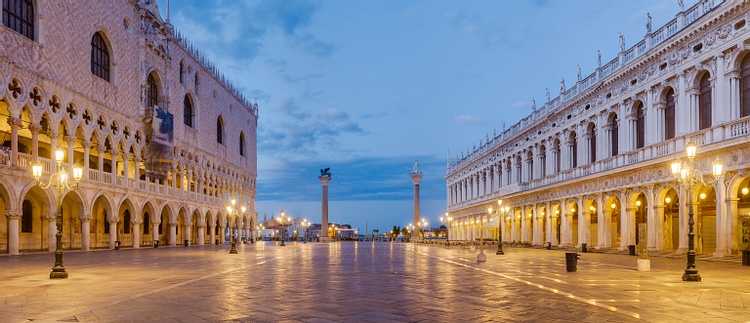
After the unification of Italy, Venice and its military forces were subsumed into the Italian state. The palace became a library, housing the Biblioteca Marciana, for a century. In the 1920s, the Doge's Palace was established as a museum, a status it continues to hold today under the control of the Fondazione Musei Civici di Venezia or Civic Museums Foundation of Venice. Today visitors can tour the palace, view the artworks and historic displays, and then walk across the Bridge of Sighs to conclude their visit with a walk through the prison.



